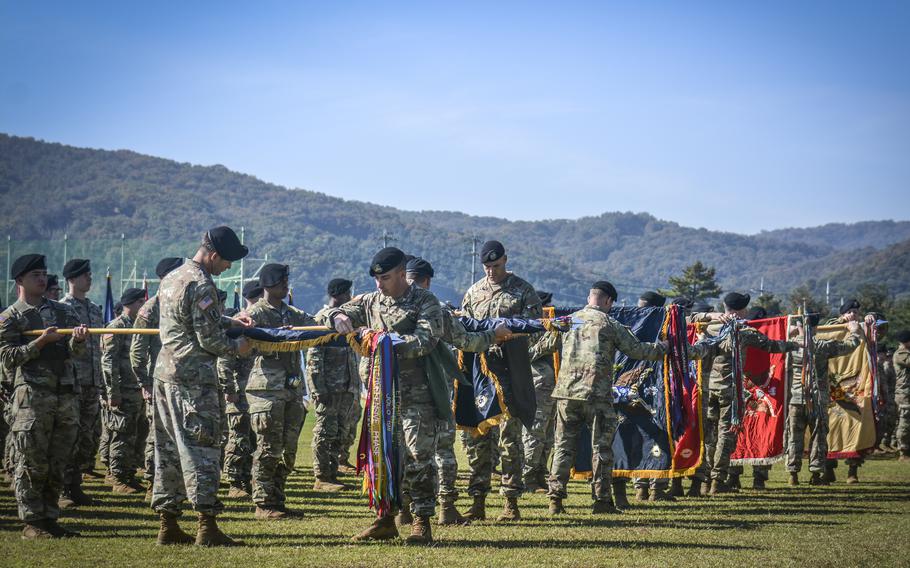
Soldiers assigned to 1st Stryker Brigade Combat Team, 2nd Infantry Division, uncase unit guidons during a transfer of authority ceremony on Indianhead Field at Camp Casey, South Korea, Oct. 25, 2024. (Luis Garcia/Stars and Stripes)
CAMP CASEY, South Korea — A Stryker combat team has taken over as the U.S. Army’s rotational force in South Korea, relieving a cavalry unit in a ceremony at Camp Casey, the U.S. base closest to North Korea.
The 1st Stryker Brigade Combat Team from Joint Base Lewis-McChord, Wash., assumed the responsibility Friday at Camp Casey, about 15 miles from the border, replacing the 3rd Cavalry Regiment out of Fort Cavazos, Texas.
The Stryker brigade is outfitted with the eight-wheeled armored combat vehicle of the same name.
The rotational force of approximately 3,500 soldiers and 1,500 prepositioned vehicles supports the 2nd Infantry Division in nine-month deployments to South Korea. The division is headquartered at Camp Humphreys, roughly 40 miles south of Seoul.
Division commander Maj. Gen. Charles Lombardo in a speech thanked the 3rd Cavalry for its service. The regiment “knocked it out of the park” during its tour, firing 2 million small arms and artillery rounds in training, driving hundreds of thousands of miles in military vehicles and conducting 60 exercises with its South Korean counterparts since Feb. 29, he said.
The regiment performed those duties while “business is not usual right now” on the Korean Peninsula.
“Our adversaries to the North are doing unusual things, and so we have got to be ready to fight tonight,” he said.
North Korean leader Kim Jong Un’s support of Russian President Vladimir Putin, with whom he signed a mutual defense pact in June, is considered potentially destabilizing on two continents Europe and Asia.
The White House on Wednesday accused North Korea of deploying thousands of troops to Russia earlier this month in support of Moscow’s invasion of Ukraine.
South Korean President Yoon Suk Yeol has demanded that Pyongyang withdraw its forces and said his office is reconsidering its policy of withholding lethal aid to Ukraine.
Closer to home, North Korea has fired more than 40 ballistic missiles in 10 separate days of testing so far this year. It last fired a short-range ballistic missile and a cruise missile on Sept. 18 that flew northeast approximately 250 miles before making landfall on the country’s eastern coast, according to the South’s Joint Chiefs of Staff.
Pyongyang since May has floated thousands of balloons carrying bags of trash across its southern border, an act its state-media claims is retaliation against South Korean activists who send anti-communist leaflets and humanitarian supplies to the North by balloon.
Col. Jeffrey Barta, 3rd Cavalry Regiment commander, said the unit was focused more on its training and building relationships with the South Korean army, rather than anything North Korea has done so far this year.
“One thing our troops will remember is the partnership with our allies and the training events that they did,” he told Stars and Stripes at Casey’s USO center Friday. “Things like being in a [South Korean] military vehicle, eating their Meals, Ready to Eat — these were super cool memories.”
Stryker brigade commander Col. Christopher Nunn thanked Barta for setting up the brigade for success.
“We’re excited to write this next chapter in our history together with our [South Korean] army teammates and the 2nd Infantry Division,” Nunn said during the ceremony. “The 1st Stryker Brigade Combat Team … is honored to assume responsibility for this strategically important mission and together with our [South Korean] army partners.”
In 2015, the Army replaced permanently positioned combat brigades with the rotational force to curb turnover among soldiers serving one- to two-year tours in South Korea.
Roughly 28,500 U.S. service members are deployed to South Korea, most of them serving at Camp Humphreys, the largest U.S. military base overseas.